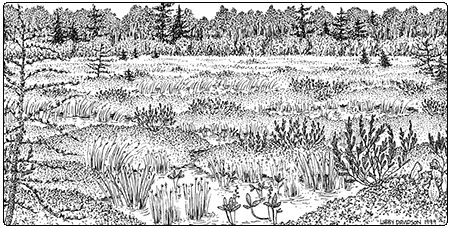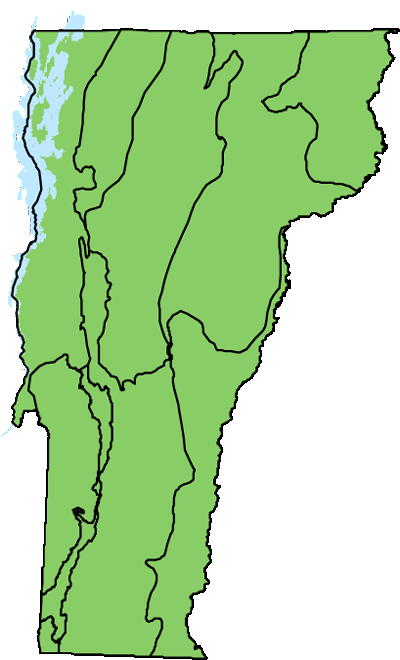Ecology and Physical Setting 
If you’re going to visit a Poor Fen, prepare to get your feet wet. In the continuum of peatland types, Poor Fens are closely related to Dwarf Shrub Bogs, but Poor Fens are wetter and typically have water levels at or near the surface of the hollows for much of the growing season. These open peatlands are dominated by sphagnum mosses, sedges, and heath shrubs. Poor Fen waters are acidic, but unlike bogs, they are slightly enriched by ground or surface water, which delivers a low concentration of dissolved minerals to the fen surface. Vegetation of the moist hollows reflects this mineral enrichment. In contrast, the tallest hummocks stand one to three feet above the water in the hollows and may be completely ombrotrophic, receiving water and nutrients entirely from precipitation. Water squeezed from sphagnum at a hummock top may have a pH near 3.5, whereas water in an adjacent hollow typically has pH ranging from 5.0 to 5.5.
 Poor Fens occur in a variety of physical settings, from small isolated basins to large wetland complexes that may be associated with streams. They generally have deep peat made up of poorly decomposed sphagnum and some sedge and woody material. They also occur as floating peat mats, growing out over the open water of small acidic ponds. Poor Fens commonly occur with Dwarf Shrub Bogs or Black Spruce Woodland Bogs, but may grade into other peatland types as well.
Poor Fens occur in a variety of physical settings, from small isolated basins to large wetland complexes that may be associated with streams. They generally have deep peat made up of poorly decomposed sphagnum and some sedge and woody material. They also occur as floating peat mats, growing out over the open water of small acidic ponds. Poor Fens commonly occur with Dwarf Shrub Bogs or Black Spruce Woodland Bogs, but may grade into other peatland types as well.
Vegetation
The well-developed hummocks of most Poor Fens are very similar to those found in Dwarf Shrub Bogs. There is a complete cover of sphagnum, with the typical zonation from hummock top to hollow bottom being Sphagnum fuscum, Sphagnum capillifolium, Sphagnum magellanicum, Sphagnum angustifolium, and Sphagnum fallax. A sparse cover of heath shrubs is present on the hummocks, with leatherleaf and bog rosemary especially common, and lesser amounts of bog laurel, Labrador tea, and sheep laurel. Stunted black spruce, tamarack, and red maple may be scattered on the widely spaced hummocks. Small cranberry, Billings’ sedge, few-flowered sedge, hare’s tail cottongrass, pitcher plant, and round-leaved sundew are all common on the hummocks.
The hollows in Poor Fens are larger and wetter than those in Dwarf Shrub Bogs, and typically contain standing water for much of the growing season. The species in these wet hollows indicate the increased enrichment as compared with Dwarf Shrub Bogs. Mud sedge and white beakrush are common, along with bog-bean, tawny cottongrass, large cranberry, and spatulate-leaved sundew. The uncommon rose pogonia and the rare pod-grass are highly characteristic of Poor Fens.
Two types of wide moist “lawns” can be found in Poor Fens. In one, the honey-brown Sphagnum papillosum forms a carpet, typically scattered with sweet gale, leatherleaf, white beakrush, and large cranberry. In the other, the bright red Sphagnum rubellum forms a carpet scattered with bog rosemary, leatherleaf, white beakrush, and small cranberry. Black-green, flat “mud bottoms” can occur in hollows and are dominated by the liverwort Odontoschisma fluitans.
Wildlife Habitat
Although small in total area, Poor Fens support an astonishing assortment of animals. A combination of factors, including openess, saturated moss, and standing water in hollows or associated small peatland ponds, makes these wetlands especially important wildlife habitat. Green frogs—and, in the northeastern part of Vermont, mink frogs—can be found in a variety of wetlands including Poor Fens. Four-toed salamanders lay their eggs in moist sphagnum and may breed in permanent fen pools in warmer regions.
Breeding birds of Poor Fens include Lincoln’s sparrow, common yellowthroat, Nashville warbler, and Wilson’s snipe. The rare ring-necked duck and the uncommon American black duck both build their nests on hummocks close to open water.
Dragonflies, damselflies, and butterflies can be abundant in Poor Fens. Among the dragonflies are the uncommon elfin skimmer and the rare, aptly-named ebony boghaunter. Other dragonflies include several species of emeralds and whitefaces. The widespread boreal bluet, and the rare sphagnum sprite and subarctic bluet, are some of the damselflies found in Poor Fens. Two of the rare butterflies found in Poor Fens rely on heath-family shrubs as host plants—bog copper caterpillars feed exclusively on cranberries, and brown elfin caterpillars feed on blueberries, huckleberries, and leatherleaf.
Related Communities
- Dwarf Shrub Bogs are dominated by sphagnum and heath shrubs and are ombrotrophic, receiving most of their water and nutrients from precipitation. Dwarf Shrub Bogs lack the mineral enrichment indicators found in Poor Fens.
- Intermediate Fens are mineral-enriched peatlands dominated by woolly-fruited sedge and sweet gale, with abundant brown mosses. Sphagnum and heath shrubs are uncommon, except on hummocks.
Conservation Status and Management Considerations
Poor Fens are rare in Vermont, and most of our examples are small. Several high-quality examples are protected. As with other wetland communities that receive nutrients and minerals from ground or surface water, Poor Fens are threatened by land use changes that occur within both their immediate watersheds and within their groundwater recharge zones. Protecting the quality and quantity of water that reaches a fen is critical to maintaining the hydrology and the vegetation structure and composition of the community.
Distribution/Abundance 
Poor Fens are rare in Vermont but are widely distributed across the state. Poor Fens are found from the northern Lake States to New England and north into Canada.
Characteristic Plants
Trees (stunted)
Occasional Species
Black spruce – Picea mariana
Tamarack – Larix laricina
Red maple – Acer rubrum
Shrubs
Abundant Species
Leatherleaf – Chamaedaphne calyculata
Bog rosemary – Andromeda polifolia
Small cranberry – Vaccinium oxycoccos
Occasional to Locally Abundant Species
Bog laurel – Kalmia polifolia
Labrador tea – Rhododendron groenlandicum
Sheep laurel – Kalmia angustifolia
Black chokeberry – Aronia melanocarpa
Large cranberry – Vaccinium macrocarpon
Herbs
Abundant Species
Mud sedge – Carex limosa
White beakrush – Rhyncospora alba
Occasional to Locally Abundant Species
Bog-bean – Menyanthes trifoliata
Tawny cottongrass – Eriophorum virginicum
Spatulate-leaved sundew – Drosera intermedia
Horned bladderwort – Utricularia cornuta
Billings’ sedge – Carex billingsii
Few-flowered sedge – Carex pauciflora
Hare’s tail cottongrass – Eriophorum vaginatum
Pitcher plant – Sarracenia purpurea
Round-leaved sundew – Drosera rotundifolia
Bryophytes

with scattered bog rosemary and small cranberry.
Abundant Species
Moss – Sphagnum capillifolium
Moss – Sphagnum rubellum
Moss – Sphagnum magellanicum
Moss – Sphagnum angustifolium
Moss – Sphagnum fallax
Occasional to Locally Abundant Species
Moss – Sphagnum papillosum
Moss – Sphagnum flexuosum
Moss – Sphagnum fuscum
Moss – Sphagnum cuspidatum
Moss – Sphagnum majus
Liverwort – Odontoschisma fluitans
Rare and Uncommon Plants
Pod-grass – Scheuchzeria palustris
Bog sedge – Carex exilis
Water sedge – Carex aquatilis var. substricta
Creeping sedge – Carex chordorrhiza
Dragon’s mouth – Arethusa bulbosa
Grass pink – Calopogon tuberosus
Rose pogonia – Pogonia ophioglossoides
Bog bedstraw – Galium labradoricum
Bog willow – Salix pedicellaris
Northern yellow-eyed grass – Xyris montana
Bog aster – Oclemena nemoralis
Atlantic sedge – Carex atlantica var. atlantica
Northeastern sedge – Carex cryptolepis
Michaux’s sedge – Carex michauxiana
Few-seeded sedge – Carex oligosperma
Twig rush – Cladium mariscoides
Marsh willow-herb – Epilobium palustre
Rough cottongrass – Eriophorum tenellum
White fringed orchis – Platanthera blephariglottis
Hidden-flowered bladderwort – Utricularia geminiscapa
Lesser bladderwort – Utricularia minor
Mountain fly honeysuckle – Lonicera villosa
Rough-leaved aster – Eurybia radula
Moss – Sphagnum lindbergii
Moss – Sphagnum pulchrum
Associated Animals
Green frog – Lithobates clamitans
Red-bellied snake – Storeria occipitomaculata
Lincoln’s sparrow – Melospiza lincolnii
Common yellowthroat – Geothlypis trichas
Nashville warbler – Oreothlypis ruficapilla
White-throated sparrow – Zonotrichia albicollis
Swamp sparrow – Melospiza georgiana
Alder flycatcher – Empidonax alnorum
Wilson’s snipe – Gallinago delicata
Mallard – Anas platyrhynchos
Boreal bluet – Enallagma boreale
Brush-tipped emerald – Somatochlora walshii
Clamp-tipped emerald – Somatochlora tenebrosa
Canada darner – Aeshna canadensis
Four-spotted skimmer – Libellula quadrimaculata
Hudsonian whiteface – Leucorrhinia hudsonica
Frosted whiteface – Leucorrhinia frigida
Belted whiteface – Leucorrhinia proxima
Rare and Uncommon Animals
Mink Frog – Lithobates septentrionalis
Four-toed salamander – Hemidactylium scutatum
Spotted turtle – Clemmys guttata
Smooth greensnake – Opheodrys vernalis
Southern bog lemming – Synaptomys cooperi
Ring-necked duck – Aythya collaris
American black duck – Anas rubripes
Bog copper – Lycaena epixanthe
Brown elfin – Callophrys augustinus
Jutta arctic – Oeneis jutta
Two-spotted skipper – Euphyes bimacula
Kennedy’s emerald – Somatochlora kennedyi
Ocellated emerald – Somatochlora minor
Forcipate emerald – Somatochlora forcipata
Delicate emerald – Somatochlora franklini
Ebony boghaunter – Williamsonia fletcheri
Elfin skimmer – Nannothemis bella
Sphagnum sprite – Nehalennia gracilis
Harlequin darner – Gomphaeschna furcillata
Subarctic darner – Aeshna subarctica
Subarctic bluet – Coenagrion interrogatum
Petite emerald – Dorocordulia lepida
Places to Visit
Dennis Pond, West Mountain Wildlife Management Area, Brunswick, Vermont Fish and Wildlife Department (VFWD)
Steam Mill Brook Wildlife Management Area, Walden, VFWD
Fairfield Swamp Wildlife Management Area, Fairfield and St. Albans, VFWD
Cranberry and Walker Swamps, Pond Woods Wildlife Management Area, Benson and Orwell, VFWD
Branch Pond, Sunderland, Green Mountain National Forest
